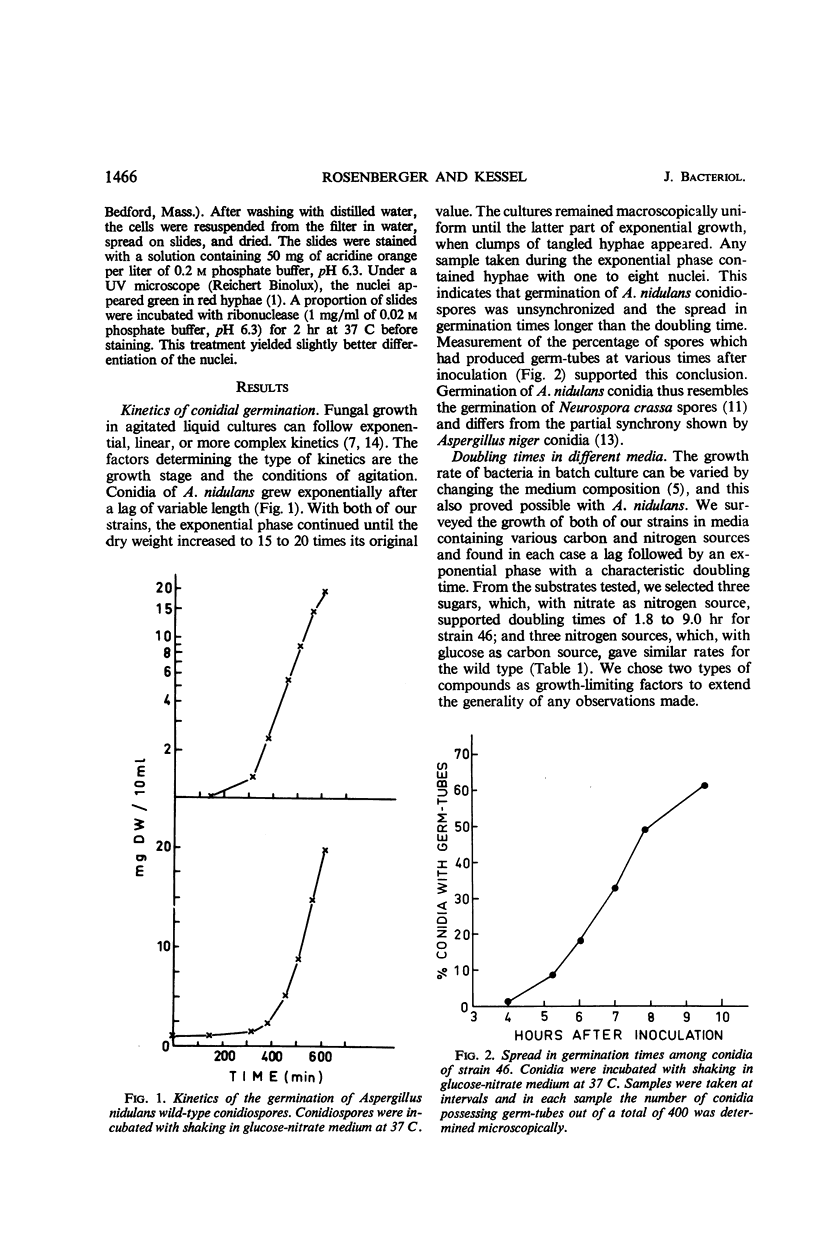Abstract
The synchrony of nuclear replication in individual, multinucleate hyphae of Aspergillus nidulans has been investigated. Samples were taken from cultures of germinating conidiospores, and the relative frequency of hyphae containing two to eight nuclei was determined. Because the conidiospores are mononucleate, complete synchrony will yield populations of hyphae containing only 2n nuclei, n being the number of doublings after germination. The appearance of hyphae with total numbers of nuclei other than 2n will indicate lack of synchrony. The relative frequency of hyphae not having 2n nuclei will depend on the degree of synchrony in the individual hyphae; numerical aspects of this relation are discussed. In two different strains, replication of the nuclei in any one hypha was highly synchronized when the dry weight doubling time was 1.4 to 1.8 hr. As the doubling time was made longer by changing the nitrogen or carbon source, synchrony was progressively lost. At the slowest growth rate tested, the interval between the division of the fastest and the slowest nucleus equaled 48% of the dry weight doubling time. The active replication of some nuclei in a hypha where other nuclei were resting suggested that nuclear duplication in this eukaryotic organism may be controlled by specific initiators.
Full text
PDF





Selected References
These references are in PubMed. This may not be the complete list of references from this article.
- Lark K. G., Consigli R. A., Minocha H. C. Segregation of sister chromatids in mammalian cells. Science. 1966 Dec 2;154(3753):1202–1205. doi: 10.1126/science.154.3753.1202. [DOI] [PubMed] [Google Scholar]
- Lark K. G., Lark C. Regulation of chromosome replication in Escherichia coli: alternate replication of two chromosomes at slow growth rates. J Mol Biol. 1965 Aug;13(1):105–126. doi: 10.1016/s0022-2836(65)80083-3. [DOI] [PubMed] [Google Scholar]
- Lark K. G. Regulation of chromosome replication and segregation in bacteria. Bacteriol Rev. 1966 Mar;30(1):3–32. doi: 10.1128/br.30.1.3-32.1966. [DOI] [PMC free article] [PubMed] [Google Scholar]
- MARSHALL K. C., ALEXANDER M. Growth characteristics of fungi and actinomycetes. J Bacteriol. 1960 Sep;80:412–416. doi: 10.1128/jb.80.3.412-416.1960. [DOI] [PMC free article] [PubMed] [Google Scholar]
- PONTECORVO G., ROPER J. A., HEMMONS L. M., MACDONALD K. D., BUFTON A. W. J. The genetics of Aspergillus nidulans. Adv Genet. 1953;5:141–238. doi: 10.1016/s0065-2660(08)60408-3. [DOI] [PubMed] [Google Scholar]
- REES H., JINKS J. L. The mechanism of variation in Penicillium heterokaryons. Proc R Soc Lond B Biol Sci. 1952 Aug 27;140(898):100–106. doi: 10.1098/rspb.1952.0047. [DOI] [PubMed] [Google Scholar]
- Taylor E. W. Control of DNA synthesis in mammalian cells in culture. Exp Cell Res. 1965 Nov;40(2):316–332. doi: 10.1016/0014-4827(65)90265-x. [DOI] [PubMed] [Google Scholar]


